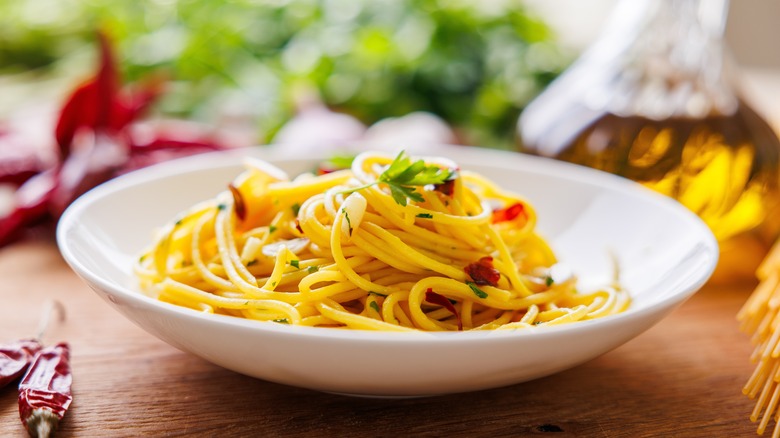Give Your Spaghetti Aglio E Olio A Flavor Punch With One Canned Ingredient
We may receive a commission on purchases made from links.
In the wide, wide world of Italian and Italian American pastas, carbonara, fettuccine Alfredo, and penne alla vodka tend to be the best known variations. While you can't go wrong with any of those, spaghetti aglio e olio is an underrated Neapolitan classic that hinges on a sauce of olive oil and garlic. If you're looking for an even more flavorful aglio e olio — with little extra effort — try incorporating canned anchovies. The fish make for an easy, yet effective, addition that transforms a simple pasta dish into a more robust, nuanced experience.
"Anchovies can add depth to aglio e olio, melting into the oil to create a complex, savory flavor," Charlotte Langley, founder of Nice Cans and Langley Foods, told Tasting Table. Her advice corresponds to various pasta recipes that also benefit from an anchovy addition; not only does it work for aglio e olio, but it's great for dishes like a last-minute weeknight carbonara. As for how, exactly, to use the fish in your next aglio e olio foray, you'll want to use anchovies packed in oil. Because canned anchovies are cured but not cooked like other canned fish, most recipes will suggest draining and cooking them before using them in your pasta.
Cook canned anchovies to create an ultra-flavorful aglio e olio
Sure, anchovies are fishy in nature, but they play a specific role in aglio e olio that far exceeds the fish category. In general, anchovies serve as a flavor enhancement, making recipes all the more savory and rich. Think of anchovies in pasta dishes the same you would consider them in a Caesar salad; rather than taking front and center, they balance alongside your dish's other ingredients, boosting your meal without overpowering it.
You can use any brand of anchovies in your next pasta dish, whether you buy a Cantabrian three-pack from Fishwife or a jar of Delfino Battista Anchovy Fillets in Oil. For the ideal texture, some recipes suggest chopping the fish before cooking it, while others use the fillets whole. It's up to you, but make sure to cook them with your oil and garlic sauce. That way, the anchovy flavor can meld with your ingredients. As Charlotte Langley explained, you essentially want the fish to dissolve into and combine with your sauce, but still impart its flavor. You'll be able to taste the difference, though it won't taste too fishy.

